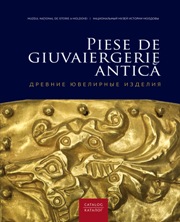This work presents to the reader the valuable historical adornments, familiarizes him with the artistic taste and the high level of craftsmanship of their creators, giving him the opportunity to take a journey in the depths of the ages to make an imagination of both the material world and the spiritual life of people of bygone eras.
The work Ancient Jewelry from the Collections of the National Museum of History of Moldova (Catalog) comprises a collection of over 2 thousand ornaments and objects of toreutics made of gold and silver, mostly discovered during the archaeological investigations in different types of sites dating from the Eneolithic to the late Middle Ages located on the present territory of the Republic of Moldova. Much of the items come from randomly discovered hoards of jewelry or hoards consisting of artifacts and coins.
The work includes three main parts.
The first chapter describes the objects of jewelry and toreutics discovered at archaeological sites of different historical periods.
The next chapter presents the hoards of ornaments or of artifacts and coins.
The objects are presented according to the following categories: adornments (earrings, temporal rings, rings, torcs, necklaces), clothing accessories (sewn-on plaques for headwear and clothing, buttons, fibulae), objects of toreutics (parts of horse harness, phalerae, scepter clips). A general characterization of the relevant historical period is also provided, complemented by information on the technique of manufacturing items. Each archaeological site is marked on a map corresponding to the historical period to which the artifacts are attributed.
The third part, the most significant, is the Catalog. Each object, or group of objects, is illustrated in color, for some items, details of the ornament, manufacturing techniques and other data are presented. For each artifact (or artifacts in the same category), there are given the name, type, place of discovery and type of archaeological site, the finder and the year of finding, the brief description: the metal of which the object is made (gold, silver), the metal purity, weight, dimensions, chronological framework, place of storage and inventory number, and selective bibliography.
 31 August 1989 St., 121 A, MD 2012, Chisinau, Republic of Moldova
31 August 1989 St., 121 A, MD 2012, Chisinau, Republic of Moldova



















































